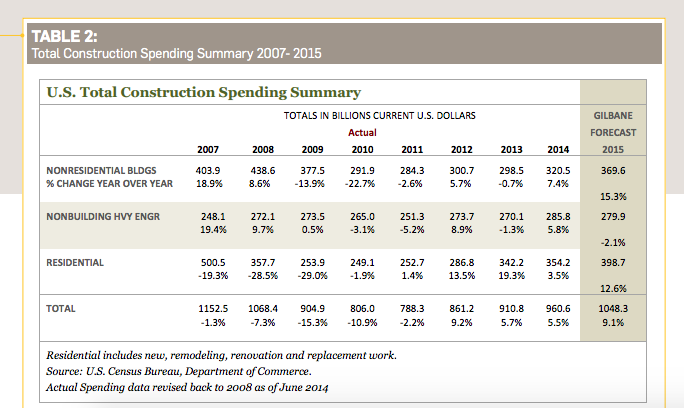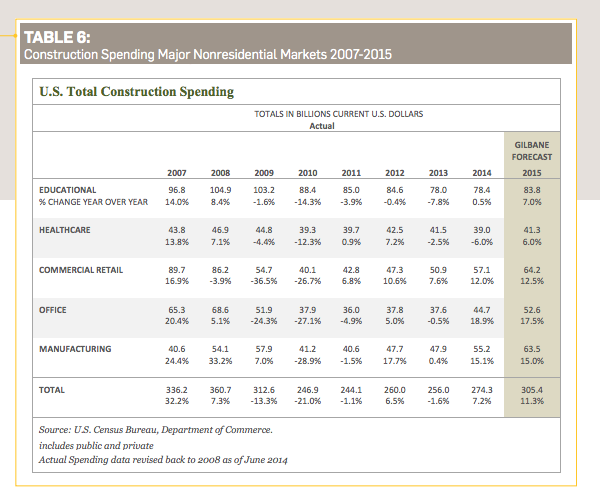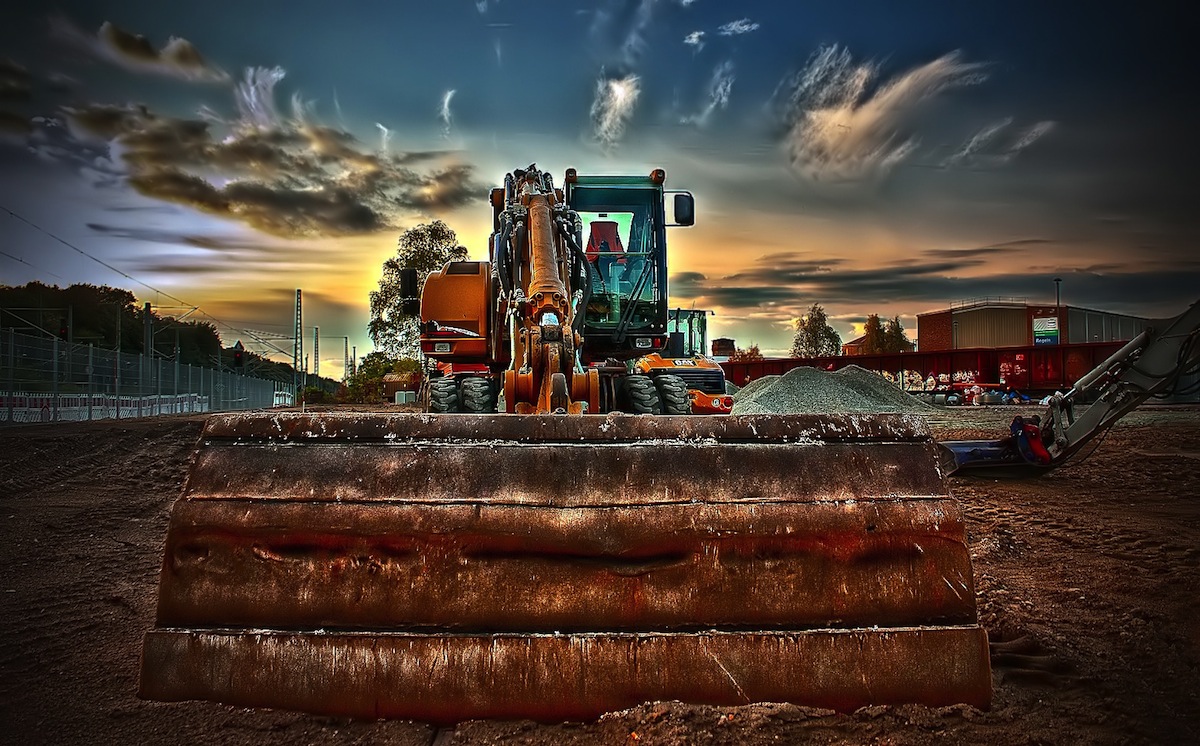Gilbane, the family owned construction and real estate development firm, is predicting stronger spending on nonresidential building this year, even if the number of projects started doesn’t appreciate significantly.
“Even if new starts growth were to turn flat for the rest of 2015 (which is not expected), those starts already recorded over the past 12 months indicate spending for nonresidential buildings in 2015 will increase 15% over 2014, the best growth since 2007,” writes the company in its “Building For the Future” Spring report on Construction Economics and Market Conditions.
Gilbane estimates that total spending for nonresidential building construction will reach $370 billion this year, a 15.3% increase. The company expects nonresidential starts to slow in 2015 but still hit 218,052 units, 7.4% ahead of the previous year.

Educational building is expected to account for 22.7% of total nonresidential construction spending in 2015, down from its 24.4% market share in 2014 and 30.3% in 2010. Still, Gilbane foresees spending on educational building to be up 7% this year, to $83.8 billion, the first substantial increase since 2008.
The manufacturing sector, whose market share of total nonresidential construction spending is projected to be flat at 17.2% this year, should see its spending amounts increase by 15% to $63.5 billion, which would be on top of a 15% gain in 2014. Spending on office construction is expected to grow 17.5% to $52.6 billion. And construction spending on commercial retail will be up 12.5% to $64.2 billion.
Gilbane projects that nonresidential construction revenue will increase by 9.1%. However, using historical benchmarks as its guide, the company believes that at least half of that gain could be attributable to “rapidly increasing inflation,” which had grown by 11% in the previous three years.

As other industry watchers have noted, Gilbane isn’t seeing much inflation on the materials side, with some exceptions like gypsum and precast concrete. Gilbane is more concerned, though, about construction hiring trends.
As of March 2015, there were 6.344 million construction employees, according to Bureau of Labor Statistics’ data. The unemployment rate in construction is now at 9.5% after hitting a low of 6.4% in October 2014. Total hiring in the construction industry was up by an estimated 15% in the first quarter of this year.
Gilbane believes that companies aren’t always using the right metrics to determine their hiring levels.
It notes that since 2012, the number of workers to complete $1 billion of constant volume has increased from about 5.65 million to 6.1 million. That would imply an 8% loss in productivity in three years. But Gilbane insists this “loss” has more to do with overall cost reductions than with projects being over-staffed.
“Workload volume should be used for planning the size of the workforce,” Gilbane states. “As an example, at the 2008 peak of construction cost, a building cost $12 million and took 100 men per year to build. In 2010, that same building potentially cost as little as $10 million to build, 20% less. Did it take 20% fewer men per year to build it? No, certainly not. That would be the fallacy of trying to determine jobs needed based on unadjusted revenue.”
To bolster its argument, Gilbane notes that historical averages (adjusted for inflation) since year 2000 show the number of direct construction jobs supported by $1 billion in construction spending varies +/- from 6,000 jobs. That calculates to one job for every $165,000 (in 2014 dollars) spent on construction, or 6.0 to 7.0 jobs per $1,000,000 spent.
Related Stories
Building Tech | Feb 20, 2024
Construction method featuring LEGO-like bricks wins global innovation award
A new construction method featuring LEGO-like bricks made from a renewable composite material took first place for building innovations at the 2024 JEC Composites Innovation Awards in Paris, France.
AEC Tech | Feb 20, 2024
ABC releases technology guide for AI in construction
Associated Builders and Contractors has released an artificial intelligence (AI) technology guide for the U.S. construction industry. AI in Construction — What Does It Mean for Our Contractors? outlines definitions, construction use cases, and considerations for the implementation of AI in construction.
Codes and Standards | Feb 20, 2024
AISC, AIA release second part of design assist guidelines for the structural steel industry
The American Institute of Steel Construction and AIA Contract Documents have released the second part of a document intended to provide guidance for three common collaboration strategies.
Student Housing | Feb 19, 2024
UC Law San Francisco’s newest building provides student housing at below-market rental rates
Located in San Francisco’s Tenderloin and Civic Center neighborhoods, UC Law SF’s newest building helps address the city’s housing crisis by providing student housing at below-market rental rates. The $282 million, 365,000-sf facility at 198 McAllister Street enables students to live on campus while also helping to regenerate the neighborhood.
MFPRO+ News | Feb 15, 2024
UL Solutions launches indoor environmental quality verification designation for building construction projects
UL Solutions recently launched UL Verified Healthy Building Mark for New Construction, an indoor environmental quality verification designation for building construction projects.
MFPRO+ News | Feb 15, 2024
Nine states pledge to transition to heat pumps for residential HVAC and water heating
Nine states have signed a joint agreement to accelerate the transition to residential building electrification by significantly expanding heat pump sales to meet heating, cooling, and water heating demand. The Memorandum of Understanding was signed by directors of environmental agencies from California, Colorado, Maine, Maryland, Massachusetts, New Jersey, New York, Oregon, and Rhode Island.
MFPRO+ News | Feb 15, 2024
Oregon, California, Maine among states enacting policies to spur construction of missing middle housing
Although the number of new apartment building units recently reached the highest point in nearly 50 years, construction of duplexes, triplexes, and other buildings of from two to nine units made up just 1% of new housing units built in 2022. A few states have recently enacted new laws to spur more construction of these missing middle housing options.
Green | Feb 15, 2024
FEMA issues guidance on funding for net zero buildings
The Federal Emergency Management Agency (FEMA) recently unveiled new guidance on additional assistance funding for net zero buildings. The funding is available for implementing net-zero energy projects with a tie to disaster recovery or mitigation.
Hospital Design Trends | Feb 14, 2024
Plans for a massive research hospital in Dallas anticipates need for child healthcare
Children’s Health and the UT Southwestern Medical Center have unveiled their plans for a new $5 billion pediatric health campus and research hospital on more than 33 acres within Dallas’ Southwestern Medical District.
Contractors | Feb 13, 2024
The average U.S. contractor has 8.4 months worth of construction work in the pipeline, as of January 2024
Associated Builders and Contractors reported today that its Construction Backlog Indicator declined to 8.4 months in January, according to an ABC member survey conducted from Jan. 22 to Feb. 4. The reading is down 0.6 months from January 2023.

















